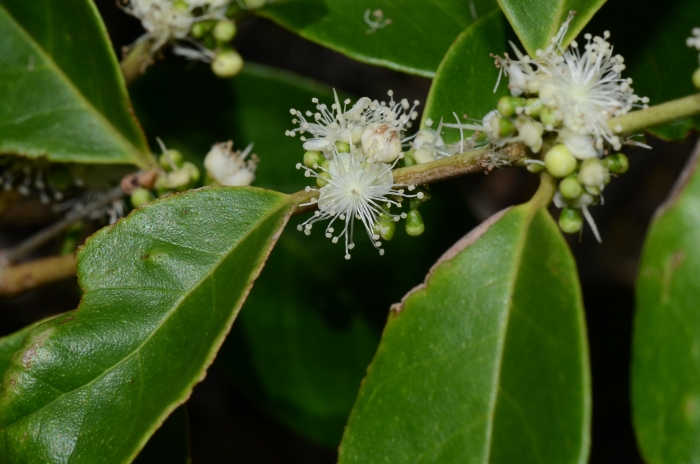Twinberry
(Myrcianthes fragrans)
Twinberry (Myrcianthes fragrans)
/
/

jimduggan24
CC BY 2.0
Image By:
jimduggan24
Recorded By:
Copyright:
CC BY 2.0
Copyright Notice:
Photo by: jimduggan24 | License Type: CC BY 2.0 | License URL: https://creativecommons.org/licenses/by-sa/2.0/ | Uploader: jimduggan24 | Publisher: Flickr |















































Estimated Native Range
Summary
Myrcianthes fragrans, commonly known as Twinberry or Simpson’s Stopper, is an evergreen shrub or small tree native to coastal hammocks, pine rocklands, and sandy soils of Florida, the United States Virgin Islands, the Caribbean, Central America, and northern South America. It can reach up to 20 feet (6 meters) in height and may grow as a multi-stemmed shrub or a small tree with a rounded canopy. The plant produces clusters of fragrant white flowers that are attractive to pollinators, followed by orange to red berries that are a food source for birds. The glossy, dark green leaves are about three inches long, elliptical, and emit a subtle nutmeg scent when crushed.
Twinberry is valued for its ornamental features, including its aromatic foliage, showy flowers, and colorful berries. It is used in native plant landscapes, as a hedge or screen, and for wildlife gardens. It is drought-tolerant once established, making it suitable for xeriscaping. Twinberry prefers full sun to part shade and adapts to a range of well-drained soils, from sandy to loamy. While generally low-maintenance, it can be susceptible to scale insects and sooty mold. Pruning can be done to maintain the desired shape and size.CC BY-SA 4.0
Twinberry is valued for its ornamental features, including its aromatic foliage, showy flowers, and colorful berries. It is used in native plant landscapes, as a hedge or screen, and for wildlife gardens. It is drought-tolerant once established, making it suitable for xeriscaping. Twinberry prefers full sun to part shade and adapts to a range of well-drained soils, from sandy to loamy. While generally low-maintenance, it can be susceptible to scale insects and sooty mold. Pruning can be done to maintain the desired shape and size.CC BY-SA 4.0
Plant Description
- Plant Type: Tree
- Height: 20-30 feet
- Width: 15-20 feet
- Growth Rate: Moderate
- Flower Color: White, Cream
- Flowering Season: Spring, Winter
- Leaf Retention: Evergreen
Growth Requirements
- Sun: Full Sun, Part Shade
- Water: Low, Medium
- Drainage: Medium, Fast
Common Uses
Bird Garden, Butterfly Garden, Fragrant, Hedges, Low Maintenance, Salt Tolerant, Street Planting
Natural Habitat
Coastal hammocks, pine rocklands, and sandy soils
Other Names
Common Names: Twinberry, Arrayan, Bois D’Inde, Bois D’Inde Batard, Bois D’Ine, Bois Mulatre, Bois Pele, Goyavier-Montagne, Guayabacon, Guayabillo
Scientific Names: , Myrcianthes fragrans, Eugenia simpsonii, Myrtus balsamica, Myrcianthes fragrans var. fragrans, Eugenia fragrans, Myrcianthes fragrans var. hispidula, Eugenia dicrana, Eugenia dichotoma, Eugenia lucayana
GBIF Accepted Name: Myrcianthes fragrans (Sw) Mc Vaugh